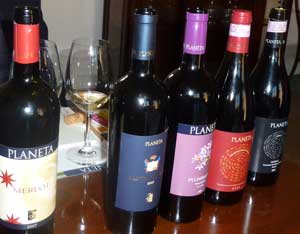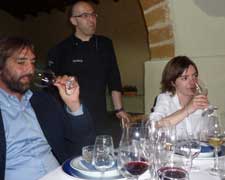Planeta: Quality, Variety and Innovation
© by Neil Duarte
When better Sicilian wines are discussed, the name "Planeta" is frequently heard. The modern company Planeta was started in 1995 by Alessio, Francesca and Santi Planeta, and today the business includes fifteen Planeta cousins. Planeta (http://www.planeta.it) has five wineries situated from the western side of the island to the eastern. A sixth winery, located near Mt. Etna in the Northeastern part of Sicily, will soon be added. The company has 371 hectares of vineyards in five separate locations where fifteen different grape varieties are grown, not including various experimental grape plantings. These include most of the traditional Sicilian grapes and a number of the international varietals.
Another key aspect of Planeta's operations is environmental sustainability. The company employs solar panels (Sicily enjoys a large number of sunny days) and biomass production to generate energy through recycling of production materials and uses recycled paper for packing and publications.
As noble as these efforts are, it is the quality of the wines that will determine the success or failure of Planeta. Let us move to that aspect of Planeta's production. Our host for the informative tour and not so brief tasting at Planeta's Ulmo Winery near the town of Sambuca di Sicilia was Marcello Arici, one of the fifteen cousins involved in the business. As we toured the vineyards and winery, Marcello explained the Planeta philosophy of use of past techniques and grapes native to Sicily in each of their areas of production combined with newer concepts of production. The company also grows both non-Sicilian Italian as well as international grapes. This continual emphasis on innovation plus a constant focus on quality of production form the basis of the strategic planning of the company.
 | |
| A Sampling of Planeta wines. PHOTO: Terry Duarte. |
Next we tasted the Planeta Chardonnay, a 100 percent Chardonnay. As with many French varietals, this grape seems to grow very nicely in Sicily. The wine was a golden color, had a nose of fruit and some wood and finished with a full body with slight acidity. This wine will last for five or so years and would be excellent with seafood.
Our final white wine was something of a surprise for me. From a previous article you might remember that I am a fan of the wines from Campania, the region that includes the city of Naples. There, the best of the white wines is the superb Fiano di Avellino. Planeta has brought the Fiano grape to Sicily where the grape grows in two of its vineyards near the town of Menfi. The resulting first vintage wine, Cometa, is a 100 percent Fiano that blew me away. Straw yellow in color, slightly fruity in the nose and dry and very pleasant with a smooth taste, this is a fantastic wine for seafood and seafood pasta dishes. I normally don't grade white wines, but this one demands it. I rated this wine as a 90 and hope it will be even better in future vintages. I bought two bottles to bring back.
The first red wine from Planeta that I had tasted here in the US before visiting Sicily was La Segreta Rosso This 50 percent Nero d'Avola, 25 percent Merlot, 20 percent Syrah and 5 percent Cabernet Franc blend is the lower end red for Planeta. Deep ruby in color, interesting in the nose and medium in the finish, this wine is a nice, reasonably priced pizza wine.
Next we tried Plumbago, a 100 percent Nero d'Avola. Fermented at 25°C with malolactic fermentation in stainless steel tanks, it is aged in barrels for eight months followed by six more months in the bottle. The resulting wine was deep red to purple in color, Somewhat fruity in the nose and soft and smooth in the taste, this is a very nice wine that will go very well with lighter meats and pasta.
Our next wine was the only DOCG wine produced in Sicily. Cerasuolo Di Vittoria. So named from the Sicilian dialect word for cherry, cerasa, this wine is produced only in the region surrounding the city of Vittoria near Ragusa. Planeta's Cerasuolo is a blend of 60 percent Nero d'Avola and 40 percent Frappato. This wine was ruby in color, somewhat fruity in the nose and long and very smooth in the finish. If you are seeking a red wine that goes as well with fish and pasta as with red meat, look no further. The Frappato softens the Nero d'Avola but does not injure the strong taste. I gave this wine a 90.
As with many Italian wineries, Planeta produces several French varietals. We tasted their Merlot, a blend of 95 percent Merlot and 5 percent Petit Verdot. Merlot is a wine that I run hot and cold on liking. The Planeta wine was ruby red in color with a nose of fruit and spice and a long and very nice finish. To achieve this it had spent fourteen months in new Allier oak casks. As with most Merlots, this one will age well for up to ten years. I withhold a rating due to my feelings on Merlot but this was indeed a very good wine.
 | |
| Lunch with Planeta's Marcello Arici (left) and Chiara Planeta (right). Chef Angelo Pumilia is in the background.. PHOTO: Terry Duarte. |
As lunch was upon us, Marcello invited us to join him, his cousin Chiara Planeta and a group of Brazilian wine enthusiasts for lunch cooked by Planeta's own chef, Angelo Pumilia. A wonderful lunch featuring typical Sicilian pasta accompanied by excellent Planeta wine and friendly conversation was a great way to end a very pleasant visit to Planeta. In the USA, Planeta is represented by Palm Bay Imports (http://www.palmbayimports.com).
Thank you to all at Planeta who made our visit so enjoyable.
June, 2011
